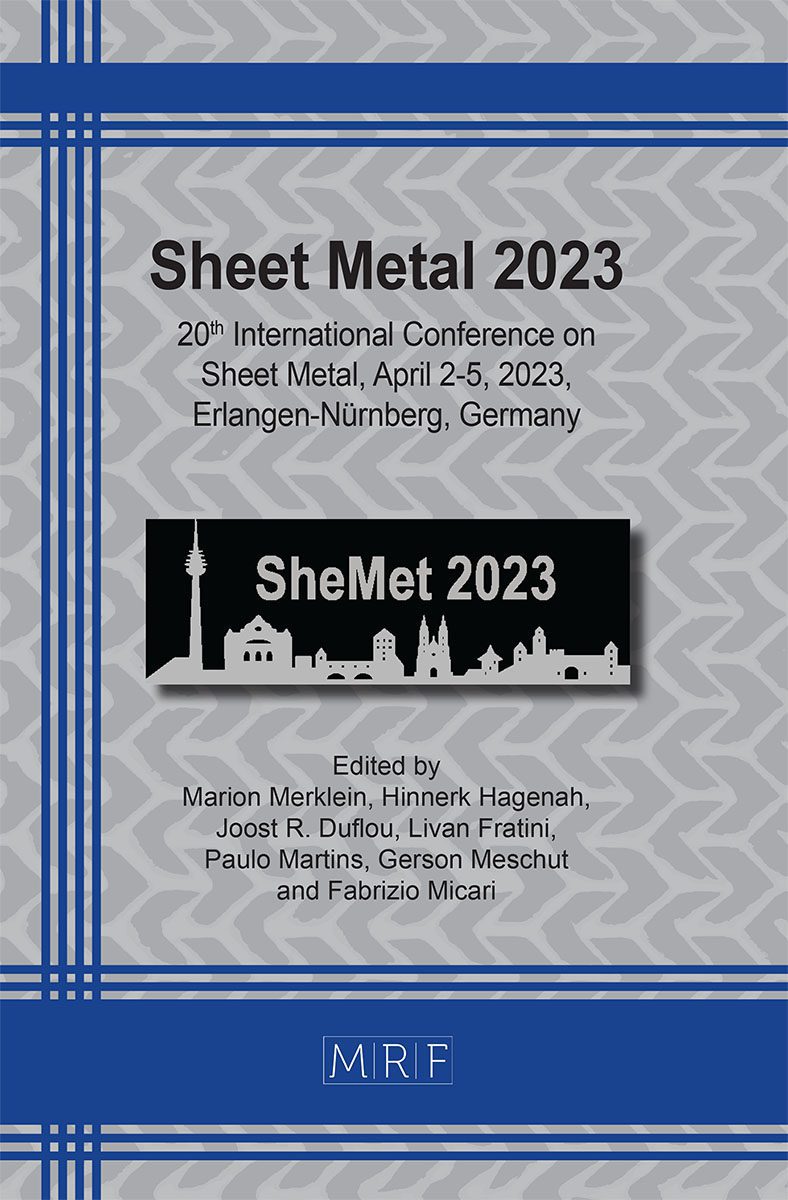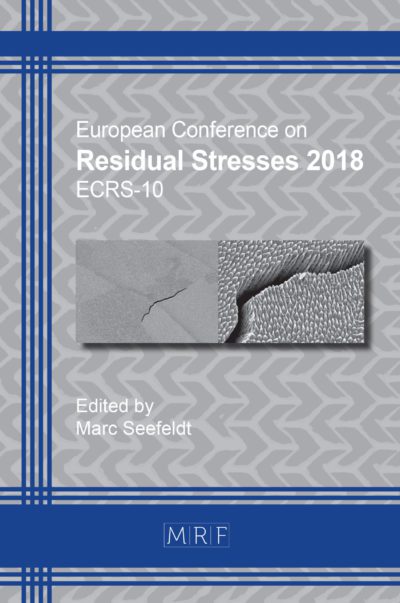Numerical and experimental investigation on the applicability of elastomer tooling components for the manufacturing of undercut geometries by sheet metal forming
Michael Ott, Yiran Li, Julian Krasselt, Florian Steinlehner, Patrick Haberkern, Albert Albers, Wolfram Volk
download PDFAbstract. Due to their approximately hyperelastic properties, elastomers are suitable as a material for forming tools with extended forming capabilities. In this work, the use of two elastomer punches for manufacturing undercuts in sheet metal forming is performed experimentally for a demonstrator component. Since the manufacturing process does not require the use of cam slide units, it is aimed at rapid prototyping and small batch applications with the goal of reducing tooling cost and complexity. Additionally, the prediction accuracy of the elastomer tool deformation during forming was investigated in a finite element model of the manufacturing process. For comparison with the experimental implementation, punch force measurements and in-process optical strain measurements with a stereo camera system were carried out.
Keywords
Rapid Prototyping, Polymer, Metal Forming
Published online 3/17/2023, 8 pages
Copyright © 2023 by the author(s)
Published under license by Materials Research Forum LLC., Millersville PA, USA
Citation: Michael Ott, Yiran Li, Julian Krasselt, Florian Steinlehner, Patrick Haberkern, Albert Albers, Wolfram Volk, Numerical and experimental investigation on the applicability of elastomer tooling components for the manufacturing of undercut geometries by sheet metal forming, Materials Research Proceedings, Vol. 25, pp 289-296, 2023
DOI: https://doi.org/10.21741/9781644902417-36
The article was published as article 36 of the book Sheet Metal 2023
![]() Content from this work may be used under the terms of the Creative Commons Attribution 3.0 licence. Any further distribution of this work must maintain attribution to the author(s) and the title of the work, journal citation and DOI.
Content from this work may be used under the terms of the Creative Commons Attribution 3.0 licence. Any further distribution of this work must maintain attribution to the author(s) and the title of the work, journal citation and DOI.
References
[1] R. Canti, Analyse für eine belastungsgerechte Auslegung von Presswerkzeugen am Beispiel Niederhalter und Schiebersystem, PhD thesis, Technische Universität München, 2016.
[2] A. Birkert, S. Haage, M. Straub, Umformtechnische Herstellung komplexer Karosserieteile, Springer Berlin Heidelberg, Berlin, Heidelberg, 2013. https://doi.org/10.1007/978-3-662-46038-2
[3] DIN Deutsches Institut für Normung e.V., DIN 8584-3:2003-09, 2003.
[4] M. Ramezani, Z.M. Ripin, Rubber-pad forming processes: Technology and applications, Woodhead Publishing, 2012. https://doi.org/10.1533/9780857095497
[5] Y. Liu, L. Hua, J. Lan, X. Wei, Studies of the deformation styles of the rubber-pad forming process used for manufacturing metallic bipolar plates, J. Power Sources, 195 (2010) 8177–84. https://doi.org/10.1016/j.jpowsour.2010.06.078
[6] A. del Prete, G. Papadia, B. Manisi, Computer Aided Modelling of Rubber Pad Forming Process, KEM 473 (2011) 637–44. https://doi.org/10.4028/www.scientific.net/KEM.473.637
[7] L. Belhassen, L. Ben Said, S. Koubaa, M. Wali, Effects of Using Flexible Die Instead of Flexible Punch in Rubber Pad Forming Processm, in: M. Haddar, F. Chaari, A. Benamara, M. Chouchane, C. Karra, N. Aifaoui, (Eds.), Design and Modeling of Mechanical Systems-III, Springer International Publishing, Cham, 2018, pp. 259–267. https://doi.org/10.1007/978-3-319-66697-6_26
[8] Fibro GmbH, Hauptkatalog Update 2022, available on https://www.fibro.de/ fileadmin/FIBRO/Blaetterkataloge/Hauptkatalog_DE/HTML5/1194/index.html, accessed 9 January 2023.
[9] Y. Liu, L. Hua, Fabrication of metallic bipolar plate for proton exchange membrane fuel cells by rubber pad forming, J. Power Sources 195 (2010) 3529–35. https://doi.org/10.1016/j.jpowsour.2009.12.046
[10] M. Elyasi, F.A. Khatir, M. Hosseinzadeh Manufacturing metallic bipolar plate fuel cells through rubber pad forming process, Int J Adv Manuf Technol 89 (2017) 3257–69. https://doi.org/10.1007/s00170-016-9297-6
[11] R.S. Rivlin, Large elastic deformations of isotropic materials IV. Further developments of the general theory, Phil. Trans. R. Soc. Lond. A 241 (1948) 379–97. https://doi.org/10.1098/rsta.1948.0024
[12] K.C. Valanis, R.F. Landel, The Strain‐Energy Function of a Hyperelastic Material in Terms of the Extension Ratios, J. Appl. Phys. 38 (1967) 2997–3002. https://doi.org/10.1063/1.1710039
[13] R.W. Ogden, Large deformation isotropic elasticity – on the correlation of theory and experiment for incompressible rubberlike solids, Proc. R. Soc. Lond. A 326 (1972) 565–84. https://doi.org/10.1098/rspa.1972.0026
[14] E.M. Arruda, M.C. Boyce, A three-dimensional constitutive model for the large stretch behavior of rubber elastic materials, J. Mech. Phys. Solids, 41 (1993) 389–412. https://doi.org/10.1016/0022-5096(93)90013-6
[15] L. Deladi, Static friction in rubber-metal contacts with application to rubber pad forming processes, PhD thesis, University of Twente, 2006.
[16] M. Ramezani, Z.M. Ripin, R. Ahmad, Computer aided modelling of friction in rubber-pad forming process, J. Mater. Process. Technol. 209 (2009) 4925–34. https://doi.org/10.1016/j.jmatprotec.2009.01.015
[17] S. Kut, B. Niedziałek, Numerical And Experimental Analysis Of The Process Of Aviation Drawpiece Forming Using Rigid And Rubber Punch With Various Properties, Arch. Metall. Mater. 60 (2015) 1923–8. https://doi.org/10.1515/amm-2015-0327
[18] Livermore Software Technology, LS-DYNA Keyword User’s Manual – Volume II Material Models (R13), available on https://www.dynasupport.com/manuals/ls-dyna-manuals, accessed 9 January 2023.
































